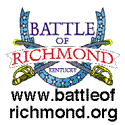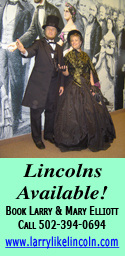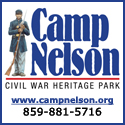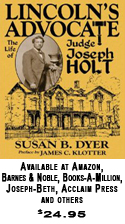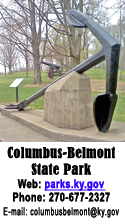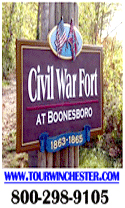|
‘We don’t glorify war…’
Telling story, educating public provides
understanding to what actually happened
By DOUG LIPPMAN
Bugle Staff Writer
Without a doubt, those of us who enjoy studying the American Civil War are a different breed. How many people, when taking their daily hike, would drive 50 miles to walk across a battlefield? How many would take their family on vacation, only to visit seven battlefields, the Museum of the Confederacy and Appomattox Courthouse? And who would wear a wool uniform in August in order to honor those who fell 150 years ago?
Those who still hear the guns usually have a favorite battlefield. While most consider Gettysburg to be our Mecca, we are usually affected by our past experiences and local geography. For those, like myself, who have lived or attended school in central Kentucky, that favorite site is frequently Perryville. Its hills and valleys appear much the same today as they did at the time of the battle.
Some experiences we never forget. While attending a re-enactment at Perryville in the early 1980s, I watched with interest as the soldiers maneuvered and fought, as cannons roared and as the cavalry flanked the enemy. Then something new caught my eye. Re-enactors must take casualties, and one soldier had fallen as if wounded in the leg very near the spectators. As the battle lines moved away, this soldier screamed in pain as he held his leg. Suddenly, a doctor ran out onto the field and began examining the casualty. We all smiled, as we knew this was all part of the act. The doctor pulled out a saw and began sawing away on the damaged leg. Some laughed, as the soldier pretended to be in agony. Then we all fell into a stunned silence. The doctor grabbed the leg and threw it to the side.
Later, we were told that the leg which had been removed was in fact artificial. This re-enactor had a fake leg, so he proceeded to have it removed, as if surgically. After a while the shock wore off, but I was hooked, and many around me seemed totally captivated by the scene we had witnessed.
By 1988, I was a re-enactor, standing on the rising slopes of Perryville and defending Parson’s Battery. We had skirmishers out at the base of the hill, but the Confederates representing Maney’s Brigade persisted in moving forward. We loaded and fired over and over. Behind us, on Starkweather’s Ridge, Union cannons boomed in support of our line, but we were forced back by the Confederate surge.
Many excellent re-enactments have been scripted and played out for the entertainment of the public at Perryville. I have participated in 10 of these over the years. But in October of 1992, something truly memorable occurred. After abandoning The Knob, the Union Army retreated into the cornfield at the base of the hill below Starkweather’s cannons. We were representing an actual occurrence, where the 21st Wisconsin Volunteer Infantry fired three volleys into the onrushing Confederates. Unfortunately, a re-enactor was seriously injured and the battle was delayed. An ambulance came onto the field, and loaded up the injured re-enactor. But all this took time, and everyone was growing impatient. Suddenly, an ear of corn flew from the Confederate side toward our lines. Almost instantly, hundreds of heavy ears of corn were flying back and forth through the air. They hurt! Fortunately, the ambulance drove off the field and we were able to resume our scripted battle. This is not normal to re-enacting, but the public and most of the re-enactors truly enjoyed the extra entertainment.
A few years later, I attended the annual celebration at Perryville with my family. As I had been researching the life of Patrick Cleburne for four years, I looked forward to a lecture which was to be given on Gen. Cleburne who had fought on this battlefield. We promptly took seats on the second row and waited for the lecture. Then we noticed that the park rangers were running around in a frenzy and whispering to one another. I was told that the speaker was not on the grounds and no one could reach him on his phone.
This was quite a coincidence. I quietly told the ranger in charge that I could deliver the lecture, as I had given many lectures on the general and my lecture notes were in my car. Instantly, a golf cart arrived and I was transported to the car where the notes were retrieved. The speech was delivered and the situation was saved. After answering several questions, I was approached by the head ranger who told me I was an angel sent from heaven. That, I assured her, was hardly the case, but I was glad to help.
My fourth role at Perryville began eight years ago. Several books have been written on the battle. The most notable authors on the subject are Kenneth Noe, Kenneth Hafendorfer, Chris Kolakowski and Stuart Sanders. After reading and studying these books and questioning local authorities such as Kurt Holman and Chuck Lott on the movements in the battle, I became a tour guide.
Serving as a tour guide is a true privilege. We represent to the people the grim realities of the battle while attempting to put a human face on those brave men who fought and died there. I serve as the link between the general public and the past. These people come from all walks of life. Occasionally, foreigners visit us and are amazed at the proceedings. But we, the tour guides, sometimes are the ones who experience the chills of the moment. You see, some of those who pay to be led up The Knob or down the “valley of death” are actual descendants of the original participants. It is an honor to speak with these people.
On the first weekend, each October, we celebrate the Battle of Perryville on the actual site. While the battle was actually fought on Oct. 8, 1862, we try our best to accommodate the public and the re-enactors by having the event begin on Fridays. Soon, I will again be leading tours up the steep hills, explaining the effects of optical illusions and acoustic shadows on the battlefield. We do not glorify war, but we do hope to educate and add understanding to what happened so long ago. Hopefully, others will be influenced so that they too will begin to hear the guns.
|


